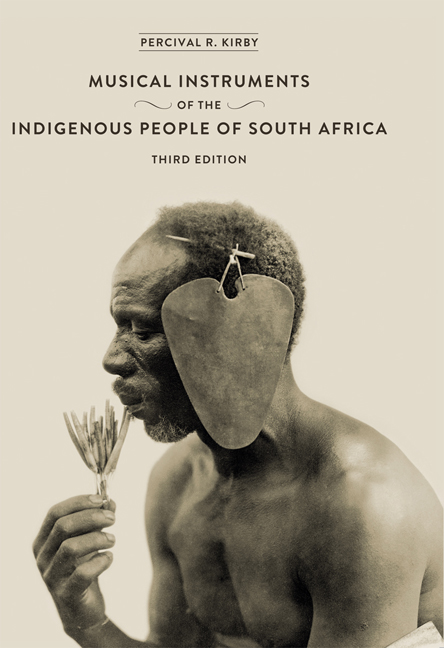Book contents
- Frontmatter
- Dedication
- Map
- Contents
- Foreword
- Preface to First Edition
- Preface to Second Edition
- Acknowledgements
- Acknowledgements to Third Edition
- List of Illustrations
- 1 Rattles and Clappers
- 2 Drums
- 3 Xylophones and ‘Sansas’
- 4 Bull-Roarers and Spinning-Disks
- 5 Horns and Trumpets
- 6 Whistles, Flutes, and Vibrating Reeds
- 7 Reed-Flute Ensembles
- 8 The ‘Gora’, A Stringed-Wind Instrument
- 9 Stringed Instruments
- 10 Bushman and Hottentot Violins and The ‘Ramkie’
- 11 Some European Instruments Played By Natives
- Appendix
- Addenda
- Index
6 - Whistles, Flutes, and Vibrating Reeds
Published online by Cambridge University Press: 21 April 2018
- Frontmatter
- Dedication
- Map
- Contents
- Foreword
- Preface to First Edition
- Preface to Second Edition
- Acknowledgements
- Acknowledgements to Third Edition
- List of Illustrations
- 1 Rattles and Clappers
- 2 Drums
- 3 Xylophones and ‘Sansas’
- 4 Bull-Roarers and Spinning-Disks
- 5 Horns and Trumpets
- 6 Whistles, Flutes, and Vibrating Reeds
- 7 Reed-Flute Ensembles
- 8 The ‘Gora’, A Stringed-Wind Instrument
- 9 Stringed Instruments
- 10 Bushman and Hottentot Violins and The ‘Ramkie’
- 11 Some European Instruments Played By Natives
- Appendix
- Addenda
- Index
Summary
THE simplest type of whistle found in South Africa consists of a single ‘stopped’ pipe, which may be, and is, constructed from various materials, such as river reeds, small antelope horns, hollow bones, or even quills. Of these the first was in all probability the earliest to be made; reeds are easily obtained and easily cut to size, and the knots form natural plugs. I have seen boys in the northern Transvaal cutting such whistles from reeds with a knife made from a short piece of hoop iron which had been sharpened on a stone; and when hoop iron was not available, they used the sharp edge of a broken flint.
A simple stopped pipe of this type is the impempe of the Zulu and Xhosa, which consists of a short length of river reed open at one end, which serves as an embouchure, and closed at the other by a natural knot. The instrument is blown by being laid on the hollowed tongue, when a blast of air, which strikes the open end at an angle, causes it to sound. Such a method of blowing is characteristically South African, and appears to me to be the earliest method used by the various peoples who have inhabited the country. These little stopped pipes usually yield only their fundamental sound, but occasionally, and especially if they are longer than usual, it is possible to elicit their first overtone, which is a twelfth above that fundamental. The pitch of the fundamental is, however, relatively high, and consequently no deliberate or artistic use is made of the overtone.
Kropf (1899) states that the impempe of the Xhosa is ‘a toy whistle used by the boys in dancing, or in calling up companions to help at a fight; it produces a sound like that made by blowing into the barrel of a key’. The use of the impempe as a signal in a fight between boys may be compared with the similar use made of bone whistles by Hottentots (vide p. 135) and by Pedi (vide p. 136-7). Bryant (1905) gives as the principal meaning of the Zulu word impempe ‘tail-spine or quill of a porcupine by which it produces a rattling sound; quill or barrel, i.e. the bottom end, empty of pith, of any feather’.
- Type
- Chapter
- Information
- The Musical Instruments of the Indigenous People of South Africa , pp. 126 - 191Publisher: Wits University PressPrint publication year: 2013



